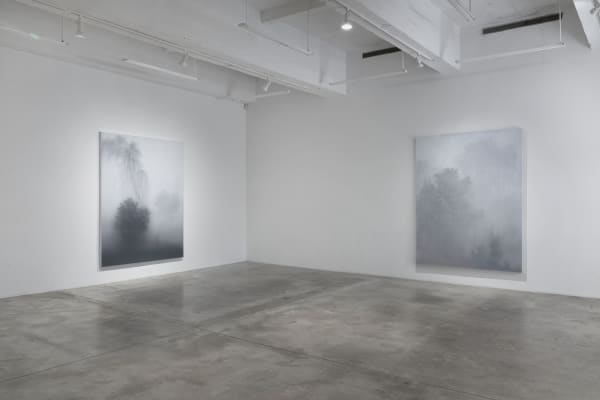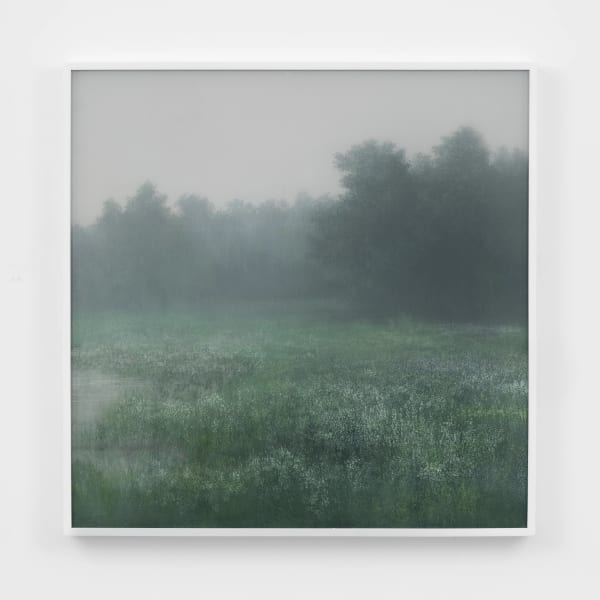Kibong Rhee: There is no place
티나킴 갤러리는 오는 2024년 10월 3일부터 11월 2일까지 이기봉(b. 1957, 서울)의 개인전,《There is no place》를 개최한다. 이기봉은 1980년대부터 물질과 정신, 생성과 소멸의 순환을 중심으로 세계의 본질을 이해하는 과정에 대한 일관된 탐구를 이어오고 있다. 그의 작업은 광선, 바람, 물, 거품과 같은 현상과 기계적 메커니즘을 결합하여 인식 너머에 존재하는 ‘보이지 않는 세계’에 대한 감각적인 사색을 구현한다. 사라짐과 유한성, 존재와 부재의 관계는 그가 오랫동안 천착해온 주제이다. 입체와 설치 등 실험적인 매체를 다루어 온 이기봉은 2000년대 이후, 운무가 자욱한 물가에 놓인 나무를 소재로 회화의 ‘장치적(device)’ 가능성, 나아가 ‘경로로써의 회화(painting as passage)’[1]에 깊이 몰두하고 있다. 이번 전시에서는 특유의 몽환적인 분위기가 두드러지는 안개 회화 연작, Mistygraphy를 중심으로 구성되었으며 특히 10미터에 달하는 대규모의 화면은 회화와 전시공간의 경계를 초월하여 ‘현재’라는 감각적인 몰입으로 우리를 안내한다. 시각적 형식 너머에 내재되어 있던 이기봉의 다차원적 시간성은 이번 전시에서 더욱 두드러진다.
실크 스크린에서 사용하는 투명한 섬유를 캔버스 위에 살짝 들어 올려 완성된 이기봉의 중첩된 레이어는 일견 사진처럼 보일 정도로 완벽한 풍경 이미지를 수확한다. 안개는 그의 회화에서 중요한 역할을 한다. "세상은 본래 흐릿하거나, 혼란스럽거나 둘 중 하나"[2]라는 작가의 언급처럼 그것은 대상을 은폐함과 동시에 그 대상에 더 가까이 다가서려는 관객의 충동을 만든다. 현실과 환상이 뒤섞인 듯 신비로운 분위기를 자아내는 이기봉의 회화는 완전한 재현을 목표로 하지 않으며, 오히려 재현의 불가능성을 탐구하는 철학적 장을 제시한다. <There is no Place>가지는 이중의 소임은 세계를 완전하게 재현하는 것이 아니라, 불완전한 세계를 회화화(繪畫化)하는 것에 가깝다.
안개로 가득 찬 풍경은 시간의 무게를 담고 있다. 미동없는 나뭇가지 위에도 침묵은 흐른다. The Left Page는 공백과 정적 위에 펼쳐진다. 아직 열리지 않은 페이지(verso)와 흘러간 시간으로 쌓여가는 페이지(recto). 과거와 미래가 모두 들어와 살고 있는 장소로서의 세계는, ‘눈 안의 극장’[3]처럼 감고 뜨는 순간마다 소멸하고 다시 태어난다. 동시대적 경험이란 재생되는 순간부터 미래를 기다리는 긴장감의 연속이자, 완결되지 않은 과거의 잔상을 붙잡는 끊임없는 시도이다.
안개 회화와 대구를 이루는 설치, Mistygraphy– Cut Section (Last)는 2016년 발표되었던 Perpetual Snow(만년설)을 가져와 변형한 것이다. 검은 배경 위에 투명한 유리를 덧대어 놓은 표면은 전시장에서 우리의 모습을 비춘다. 작가의 손을 본떠 만든 기계장치가 유리판 위에 작고 둥근 원을 무수히 만들며 태초 이래 ‘영원한 반복’을 수놓았던 키네틱 작품은 오늘에 이르러 일시적인 순간의 잔상을 비추는 거울이 된다. 관객은 작품 속에서 자신의 시간을 발견하고, 세계의 존재와 부재를 동시에 경험한다.
이기봉은 그의 작품을 통해 단순히 무엇이 있는가를 묻는 것이 아니라, 무엇이 사라지고 있는가를 끊임없이 질문한다. 스스로가 몇 번이고 다시 죽어 또 살아나는 안개 속 존재들은 우리에게 재현 가능한 것이 무엇인지, 세계의 한계 지점에는 무엇이 있는지, 한계를 통해 드러나게 되는 것, 혹은 그 곳에서만 발생할 수 있는 것에 대한 사유를 우리에게 던지고 있다.
작가 소개
1957년, 서울에서 태어난 작가는 서울대학교에서 수학했다. 1986년 대한민국미술대전에서 대상을 수상한 후 전 세계적으로 광범위하게 전시를 이어가고 있다. 주요 작품 소장처로는 국립현대미술관, 호암미술관, 리움미술관, 카를스루에 ZKM(Zentrum für Kunst und Medien)미술관 등이 있으며, 2021년 LA 카운티 미술관(Los Angeles County Museum of Art)의 단체전에서 그의 작품이 소개되었다. 작가는 2016 창원조각비엔날레, 2012 미디에이션 비엔날레(Mediations Biennale), 2011 모스크바 비엔날레, 2010 부산비엔날레, 2009 비엔날레 큐베(Biennale Cuvée), 그리고 2008 세비야 비엔날레(Sevilla Biennale) 및 2008 싱가포르비엔날레 등에 참여한 바 있다.
-

Kibong Rhee's Misty Landscapes Reveal Hidden Shadows
Impulse October 31, 2024Tina Kim Gallery presents There is no place , a solo exhibition by artist Kibong Rhee (b. Seoul, 1957). While sculpture and installation had been...Learn More -

The Mind-Body Split in Kibong Rhee’s Paintings
Hyperallergic October 22, 2024In August of 2022, I spent an afternoon in Kibong Rhee’s studio in Gwangju, South Korea, about an hour north of Seoul. Ever since that...Learn More -

The Shows You Need to See in New York This October
Elephant October 8, 2024This month’s edition features a variety of emerging talent, mixed media, and galleries that have traversed various models ranging from pop up, to residency, to...Learn More








